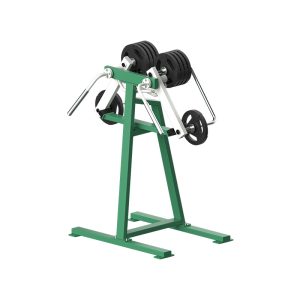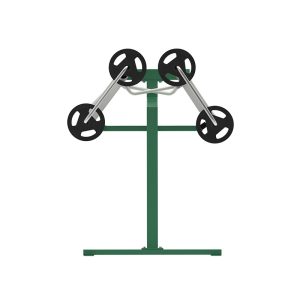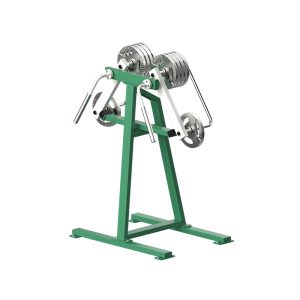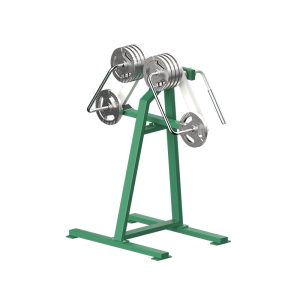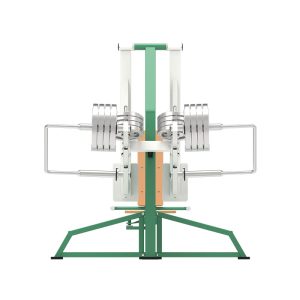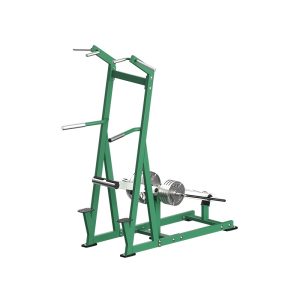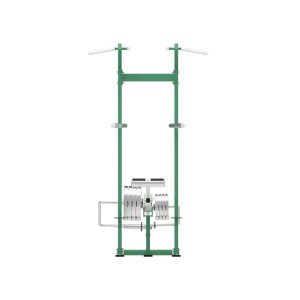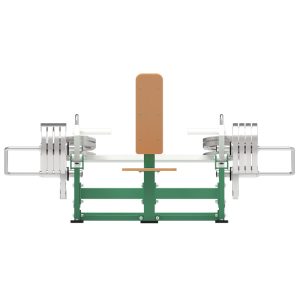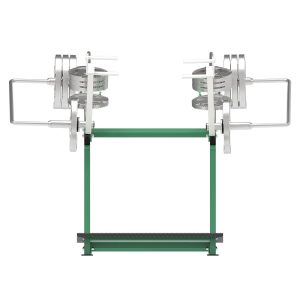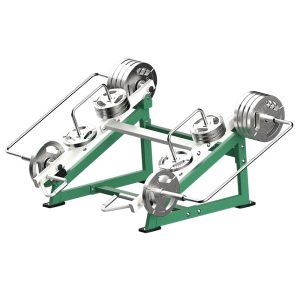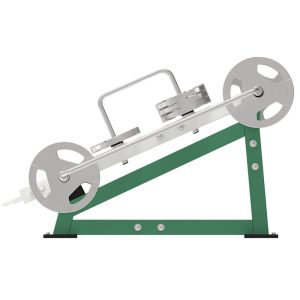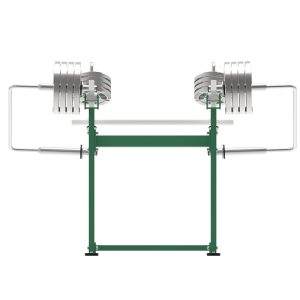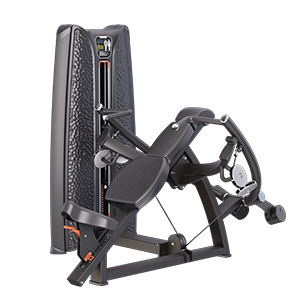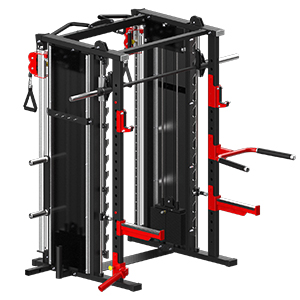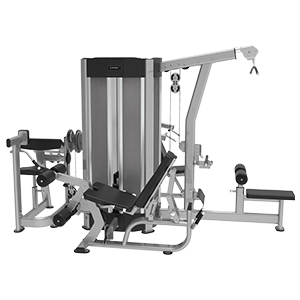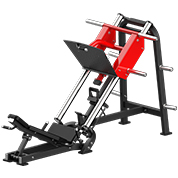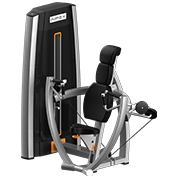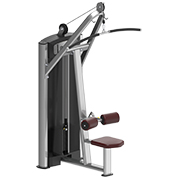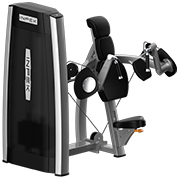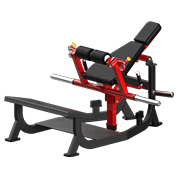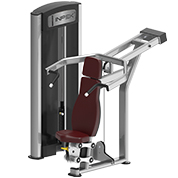- Home
- /
- Plate Loaded Machines
2025 Best Plate Loaded Machines for Strength Training
Plate loaded machines are a core addition to any commercial gym, offering a versatile and effective alternative to free weights. Built for durability, these machines from Inpek Fitness feature precision-crafted, laser-cut frames that support higher weight capacities, making them suitable for both beginners and experienced lifters. Each plate loaded machine is designed to deliver smooth motion and adjustable resistance, allowing users to personalize their workouts by adding or removing Olympic plates with ease. Inpek Fitness’s range of plate loaded machines includes specialized equipment tailored for precise muscle targeting and strength development: Shoulder and Chest Trainers: Our lineup includes Double Track Incline Shoulder Press, Seated Shoulder Press, Flat Bench Chest Press, Incline Chest Press, and Seated Chest Press machines. These machines offer focused support for shoulder and chest muscle growth, enabling heavy lifting with guided motion for a safe workout. Back and Pull Trainers: With machines such as the Double Track High Back Pull, Standing Back Pull, Low Push-Pull, and Incline Back Pull, our back-focused options provide comprehensive strength training for the upper, middle, and lower back. The Scissor Pull Back and Seated Pull Back Trainers further support effective back workouts, targeting multiple muscle groups with optimal movement control. Leg and Lower Body Trainers: Our Seated Leg Press, 45° Reverse Press, Lying Squat, Prone Leg Press, and Seated Quadriceps Trainers allow for robust lower body workouts, from quads to glutes. The Standing Squat Comprehensive Trainer and Glute Bridge Trainer are particularly popular for building lower body strength, designed to align with natural body movement. Functional and Multi-Use Trainers: The Deadlift Trainer, Standing Multi-Function Comprehensive Trainer, and Push Trainer cater to varied exercises, making them versatile tools in a strength training routine. These machines enable users to engage multiple muscle groups with plate-loaded resistance, enhancing flexibility and workout effectiveness. Inpek Fitness plate loaded machines seamlessly integrate into gym environments by accommodating standard Olympic plates, allowing for easy movement of weights across equipment. This efficiency supports facility layouts and enables gym owners to make strategic equipment investments by purchasing plates separately. Known for durability and reliability, Inpek Fitness’s plate loaded machines are an asset to any fitness center, ensuring safe, effective, and adaptable strength training for users at all levels.
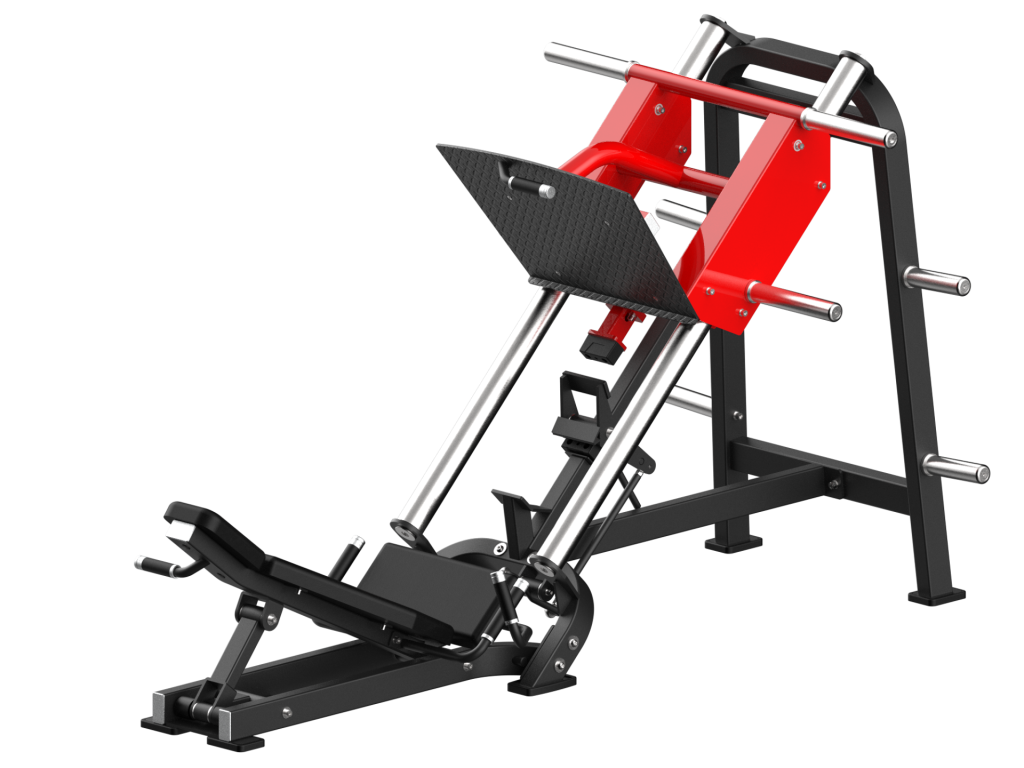
The K18 Plated Loaded Series
The K18 Plated Loaded Series is a transferable maintenance-free series that includes upper and lower limb trunk muscle training functions. It can be used for single-arm and single-led exercises, as well as simultaneous Iso-lateral exercises. The product design conforms to the natural human movement trajectory, reducing the risk of injury and enhancing the effectiveness of daily exercise. It is highly durable and can withstand rigorous exercise intensity, making it suitable for explosive strength training.

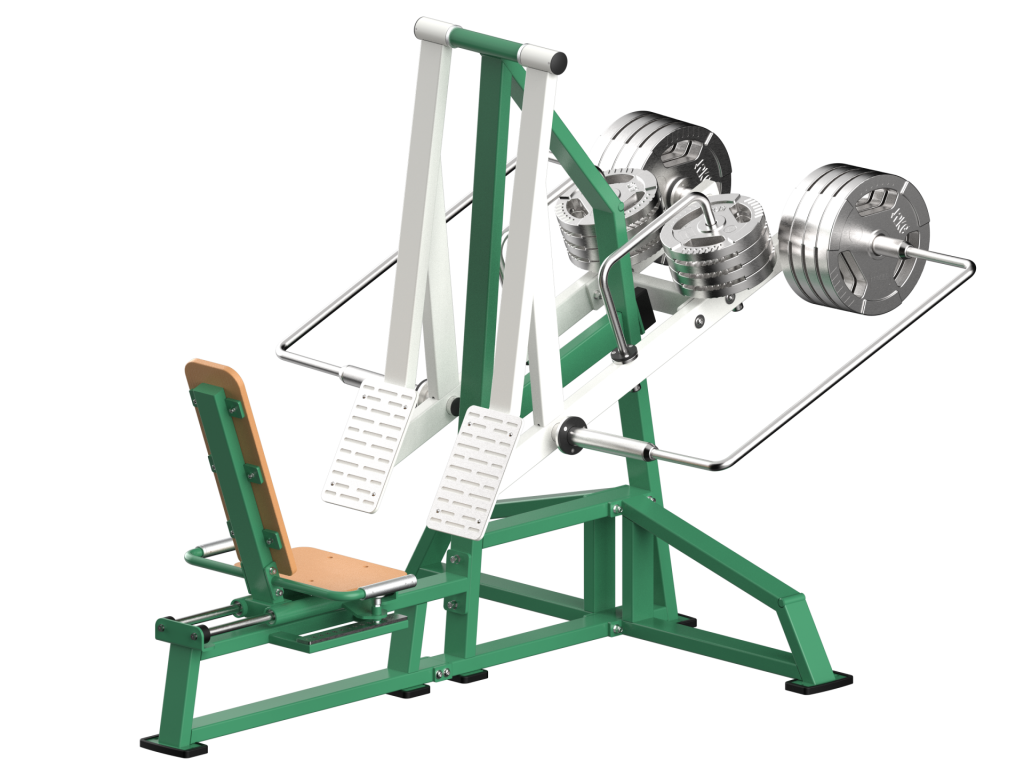
The K38 Outdoor Series
The K38 Outdoor Series is an outdoor equipment developed based on the K18 series. The product integrates the precise motion trajectory of the K18 series and has been redesigned for the counterweight area.
The frame is made of 3mm rectangular pipe, with a stable and sturdy structure. Fine welding
technology provides the firmness and aesthetics to the main structure. The surface of the equipment adopts physical and mechanical rust removal, and the electrostatic spraying process effectively prevents corrosion, making it more durable and long-lasting.

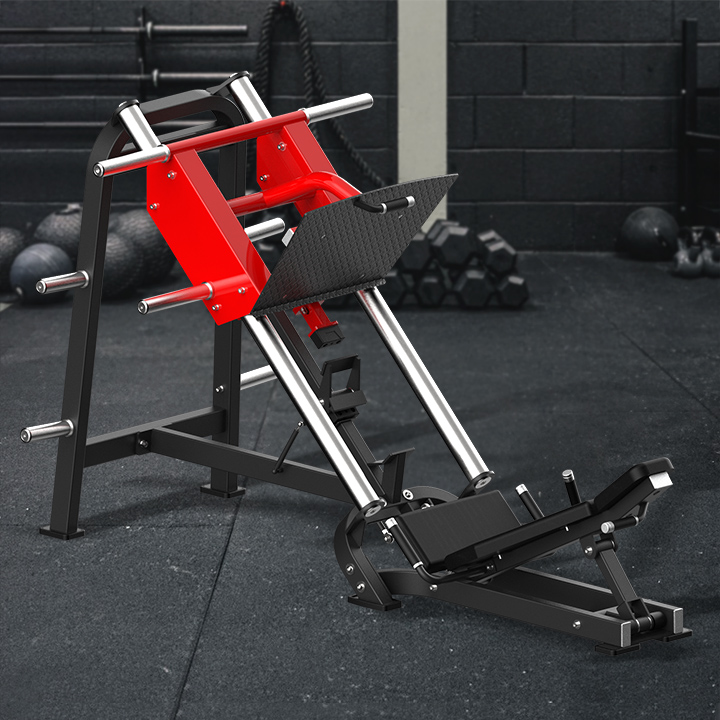
Commercial Plate Loaded Machines for Sale
Overview of the Market for Commercial Plate Loaded Machines
The commercial plate loaded machines market has expanded significantly due to the growing popularity of strength training in fitness facilities. As gyms seek to enhance their equipment offerings, plate loaded machines have become a staple for building muscle and improving overall fitness.
These machines are particularly valued for their ability to provide a stable platform for heavy lifting while allowing users to focus on proper form and technique. The versatility of plate loaded equipment enables a wide range of exercises targeting various muscle groups.
With advancements in technology and design, manufacturers are now offering a diverse range of plate loaded machines that cater to different fitness levels and preferences. This includes specialized equipment for leg presses, squats, and upper body workouts, ensuring that gyms can meet the needs of all their members.
Factors to Consider When Purchasing
Durability and Build Quality:
It is crucial to invest in machines that are built to withstand the rigors of constant use in a commercial environment. Look for equipment made from heavy-duty steel frames, with reinforced connections and high-quality padding to ensure longevity. A solid warranty and availability of replacement parts are also essential considerations, as they indicate the manufacturer’s confidence in their product and support for maintenance needs.
Space Requirements:
Space is often a premium in gyms, making it essential to evaluate the footprint of each machine. Measure available workout areas to ensure that the equipment fits comfortably and allows for safe movement around it. Additionally, consider multi-functional plate loaded equipment that can perform various exercises within a compact design, maximizing the use of limited space.
Features and Functionality:
Advanced features can enhance the user experience significantly. Look for machines with adjustable weight plates, intuitive controls, and safety features such as locking mechanisms. Ergonomic designs that accommodate different body sizes and shapes are also important. Machines with adjustable seats, footplates, and backrests provide a tailored fit for each user, promoting safety and effectiveness during workouts.
Advantages of Plate Loaded Machines
Versatility:
Plate loaded machines can be used to target multiple muscle groups, making them ideal for full-body workouts. Users can perform a variety of exercises, from squats and bench presses to deadlifts and shoulder presses, facilitating comprehensive training that addresses all major muscle areas.
Durability:
Constructed with high-quality materials, plate loaded machines are built to withstand heavy use in commercial gym settings. Their robust construction ensures that they maintain performance and reliability over time, making them a sound investment for gym owners.
Natural Range of Motion:
Many plate loaded machines are designed to allow for movement patterns that closely mimic natural body movements. This feature helps reduce the risk of injury, as users can perform exercises with a more ergonomic motion, enhancing both safety and workout effectiveness.
Customizable Resistance:
Users can easily adjust the weight by adding or removing plates, allowing for precise control over the resistance and intensity of their workouts. This adaptability makes it simple to tailor training sessions to suit individual strength levels and goals, promoting progressive overload as users advance.
Cost-Effectiveness:
Compared to selectorized weight machines, plate loaded equipment is generally more affordable while still offering similar benefits.
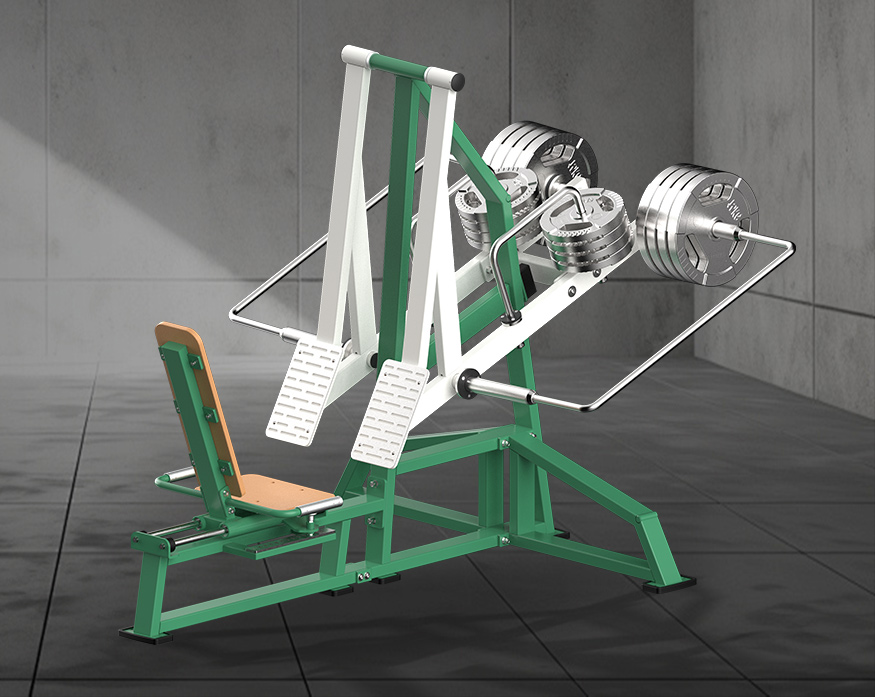
Plate Loaded Gym Equipment Manufacturers
Overview of Reputable Manufacturers in the Plate Loaded Equipment Market
At Inpek Fitness, we are proud to be recognized as a leading fitness equipment company dedicated to excellence in the industry. Our focus is on providing comprehensive training products that cater to the diverse needs of fitness enthusiasts and professionals alike.
Innovative Design and Development:
Our strength lies in our innovative approach, supported by a dedicated team of 16 professional designers within our independent R&D department. This expertise enables us to create equipment that not only meets but exceeds customer expectations in terms of both appearance and functionality.
We place a strong emphasis on personalization, allowing us to tailor products to the specific requirements and preferences of our clients. This customization ensures that our equipment fits seamlessly into any training environment.
Commitment to Customer Service:
We operate under the guiding principle of “achieving customers,” which drives our commitment to exceptional service. This philosophy is evident in every aspect of our operations, from product development to after-sales support.
Our customer-centric approach means we listen closely to feedback and continuously seek ways to enhance our offerings, ensuring that our partners receive the highest level of service.
Quality Assurance and Testing:
To uphold our commitment to quality, we have established our own quality testing laboratory. This facility allows us to rigorously evaluate our products against industry standards, ensuring that we deliver only the best to our customers. As we look to the future, we remain dedicated to optimizing our strengths and capabilities. We aim to enhance our service offerings and innovate our product line continually. In the plate loaded equipment market, we are witnessing significant advancements driven by technology and innovation. At Inpek Fitness, we prioritize enhancing user experience by incorporating ergonomic designs and adjustable features into our products. This focus on usability ensures that our equipment is not only functional but also comfortable for users during their workouts. We are excited to integrate digital technology into our machines, including innovations like adjustable weight systems and smart technology that tracks workout data. These advancements not only improve the usability of plate loaded machines but also help users achieve their fitness goals more effectively. By providing real-time feedback and personalized workout metrics, we empower our customers to maximize their training efforts. Additionally, we recognize the importance of sustainability in our production processes. We are committed to utilizing eco-friendly materials and practices, aligning our operations with the values of environmentally conscious consumers and businesses. This commitment not only helps reduce our environmental footprint but also meets the growing demand for sustainable fitness solutions. Choosing equipment from reputable manufacturers like Inpek Fitness is essential for ensuring quality and safety in any gym environment. We take pride in producing high-quality plate loaded equipment that can withstand the demands of daily use, significantly reducing the likelihood of breakdowns and injuries. We believe that reliable manufacturers should offer comprehensive warranties and exceptional customer support, which are crucial for maintaining equipment over time. This assurance is especially important for commercial gyms, where equipment downtime can negatively impact revenue and user satisfaction. We are dedicated to enhancing the training experience for our members and partners, and we look forward to continuing to innovate and deliver the highest quality fitness solutions.
We understand that quality, reliability, and performance are paramount in the fitness industry, and our testing processes reflect this understanding.
Future Goals and Partnerships:
Our goal is to become the most reliable supplier for our partners, fostering long-term relationships built on trust and mutual success. We are excited about the prospect of future collaborations and the opportunity to contribute to our partners’ success in the fitness industry.Discussion on Innovation and Technology Trends in Manufacturing
Importance of Choosing Reliable Manufacturers for Quality Assurance
Collaborate with Inpek Fitness Experts for Your Commercial Gym Projects
Looking to enhance your gym with premium equipment? Have inquiries or ideas? Complete the form below to engage with our expert team. We’ll work with you to realize your fitness facility goals efficiently and effectively.
FAQs about Plate Loaded Machines
Is the plate-loaded leg press easier than the machine?
The ease of using a plate-loaded leg press compared to a machine leg press often varies based on individual preferences and experience. Plate-loaded leg presses allow users to customize the weight to suit their strength levels, which can make them feel easier or more manageable, especially for beginners who are gradually increasing their strength. However, machine leg presses typically feature guided tracks that provide stability and support, which can make them easier to use for those unfamiliar with strength training. The controlled movement of machine leg presses can help beginners maintain proper form, reducing the risk of injury. Ultimately, the perceived difficulty will depend on personal comfort with the equipment and the specific mechanics of each machine. It’s beneficial for individuals to try both options to see which feels more comfortable and effective for their workout routines.
Are plate-loaded machines effective?
Plate-loaded machines are widely recognized for their effectiveness in strength training. These machines provide a stable platform for users to perform a variety of exercises, allowing for targeted muscle engagement. They are designed to facilitate proper form and reduce the risk of injury, making them ideal for both beginners and experienced lifters. Additionally, plate-loaded machines enable users to progressively increase the weight, promoting muscle growth and strength over time. They can isolate specific muscle groups, making them particularly useful for targeting areas such as the legs, chest, and back. While some may argue that free weights offer more versatility, plate-loaded machines play a significant role in a well-rounded strength training program. By incorporating these machines into their workouts, individuals can achieve effective results and enhance their overall fitness levels.
Are plate-loaded machines cheaper?
In general, plate-loaded machines can be more affordable compared to other types of fitness equipment, particularly those that incorporate advanced technology or automated features. The simplicity of the design, which relies on standard weight plates for resistance, often leads to lower manufacturing costs. This can make plate-loaded machines an attractive option for budget-conscious gyms. However, pricing can vary widely depending on the brand, model, and features included. While entry-level plate-loaded machines may be relatively inexpensive, high-end models with enhanced durability and performance features can be quite costly. It’s important for potential buyers to consider the long-term value of investing in quality equipment. By selecting well-made plate-loaded machines, users can ensure they receive a reliable workout tool that will last for years, providing an excellent return on investment.
Does wearing a plate carrier build muscle?
Wearing a plate carrier can indeed contribute to muscle building when integrated into a well-structured workout routine. The added weight of a plate carrier increases the resistance during bodyweight exercises, such as push-ups, squats, and lunges, which can stimulate muscle growth and strength gains. By incorporating a plate carrier into workouts, users can challenge their muscles more effectively, leading to enhanced hypertrophy (muscle growth). However, it is crucial to focus on proper form and technique to avoid injury, especially when performing high-impact movements. For optimal results, individuals should combine the use of a plate carrier with a balanced strength training program that includes a variety of exercises targeting different muscle groups. Additionally, maintaining a proper diet and allowing for adequate recovery time is essential to support muscle growth and overall fitness development.
Are weight machines worth it?
Weight machines can be a worthwhile investment for many individuals and fitness facilities, especially for those focused on strength training. They provide a safe and controlled environment that is ideal for beginners and those recovering from injuries. With guided movements, weight machines help users maintain proper form, which can reduce the risk of injury during workouts. Furthermore, machines often allow for targeted muscle training, enabling users to focus on specific areas of the body effectively. While some may prefer the versatility of free weights, weight machines can complement a comprehensive fitness program. The convenience of quick adjustments in resistance and the support they offer can enhance workout efficiency. Ultimately, whether weight machines are worth it depends on individual fitness goals, preferences, and the overall structure of a training regimen. For many, they represent a valuable component of a balanced approach to fitness.
What is the difference between pin-loaded and plate-loaded leg press?
The primary difference between pin-loaded and plate-loaded leg presses lies in how resistance is applied. Pin-loaded leg presses use a stack of weight plates connected to a pin system. Users can adjust the resistance by inserting a pin into different slots on the weight stack, allowing for quick changes in weight without manually loading plates. This design can be more convenient for those who want to switch weights easily during their workout. In contrast, plate-loaded leg presses require users to manually load weight plates onto the machine. This setup allows for greater customization in terms of total weight, as users can add as many plates as they desire, making it appealing for those who lift heavy. Both types of leg presses effectively target the leg muscles, but the choice between pin-loaded and plate-loaded often comes down to personal preference and the desired workout experience.
How heavy is 1 plate machine?
The weight of a single plate on a machine can vary based on the specific equipment and the type of weight plates used. Standard weight plates typically weigh 45 pounds (20.4 kilograms) in the United States, but there are lighter options available, such as 25-pound (11.3 kilograms) and 10-pound (4.5 kilograms) plates, among others. Additionally, some machines may use different types of plates or have their own specific weight standards, especially in commercial gyms where various equipment brands are present. It's important to note that the weight stack on machines that use pin-loaded systems will also vary, with the total weight determined by how many plates are added or which pin slot is selected. For those using plate-loaded machines, understanding the weight of each plate is essential for planning workouts and ensuring proper form and safety during exercise. To accurately gauge how heavy a single plate machine is, refer to the specifications provided by the manufacturer or check the labels on the plates themselves.
What is a plate-loaded machine?
A plate-loaded machine is a type of strength training equipment that utilizes weight plates for resistance. Unlike machines that have built-in weight stacks, plate-loaded machines require users to manually load plates onto the machine according to their desired weight. This allows for greater customization and flexibility in terms of resistance levels, making it suitable for both beginners and experienced lifters. Plate-loaded machines are commonly used for various exercises, including leg presses, chest presses, and rows. They often feature adjustable seats and backrests to accommodate users of different sizes, ensuring proper form and comfort during workouts. The design of plate-loaded machines can help target specific muscle groups effectively, providing an excellent way to build strength and improve muscular endurance. By allowing users to adjust the weight to their own capacity, plate-loaded machines also promote progressive overload, a key principle for muscle growth. Overall, plate-loaded machines are versatile tools that can enhance any strength training program.
What does plate-loaded row work?
The plate-loaded row machine primarily targets the muscles in the upper body, specifically the back muscles, biceps, and shoulders. When using this machine, the primary focus is on the latissimus dorsi, the large muscles in the back responsible for pulling movements. Additionally, the plate-loaded row engages the trapezius and rhomboid muscles, which are essential for proper posture and upper body strength. The biceps also play a significant role during the rowing motion as they assist in pulling the weight toward the body. Using a plate-loaded row machine allows for greater control and stability, which can help users maintain proper form throughout the movement. This focus on form can be particularly beneficial for beginners learning the mechanics of rowing. The adjustable weight allows users to increase resistance progressively, promoting muscle growth and endurance. Incorporating plate-loaded rows into a workout routine can enhance upper body strength, improve posture, and contribute to overall fitness goals.
How do you use a plate-loaded chest press machine?
Using a plate-loaded chest press machine involves several steps to ensure safety and effectiveness. First, adjust the seat height so that the handles are at chest level when seated. This positioning is crucial for maintaining proper form during the exercise. Next, load the appropriate weight plates onto the machine, ensuring they are securely in place. Sit down on the machine and firmly grasp the handles with both hands. Keep your feet flat on the floor and your back against the padded seat for support. As you prepare to begin, take a deep breath, and slowly push the handles away from your chest, extending your arms fully without locking your elbows. Focus on engaging your chest muscles throughout the movement. After reaching the peak of the press, gradually return the handles to the starting position, maintaining control of the weight. It is essential to keep a steady pace and avoid using momentum to perform the exercise. Repeat for the desired number of repetitions, and remember to adjust the weight as needed for your fitness level.
How do you use a plate-loaded hip thrust machine?
Using a plate-loaded hip thrust machine effectively targets the gluteal muscles and can be a key exercise in any strength training regimen focused on lower body development. Start by adjusting the machine to fit your body size, ensuring that the padded bar is positioned comfortably against your hips when seated. Next, load the appropriate weight plates onto the machine, making sure they are secure. Sit on the machine with your back against the padded support and your feet flat on the ground, about shoulder-width apart. As you prepare to perform the hip thrust, take a deep breath and brace your core. Push through your heels, thrusting your hips upward while maintaining a neutral spine. The goal is to lift your hips as high as possible, squeezing your glutes at the top of the movement. Hold for a moment before lowering your hips back to the starting position. It’s essential to maintain control throughout the exercise to maximize glute engagement and minimize the risk of injury. Repeat for the desired number of repetitions, adjusting the weight as necessary to match your strength level.
Why are plate-loaded machines better?
Plate-loaded machines offer several advantages that make them a preferred choice for many fitness enthusiasts and professionals. One of the primary benefits is the ability to customize resistance levels by adding or removing weight plates. This flexibility allows users to tailor their workouts to their specific strength levels and training goals, promoting progressive overload, which is essential for muscle growth. Additionally, plate-loaded machines provide a stable platform for performing exercises, helping users maintain proper form and reducing the risk of injury. This stability is particularly beneficial for beginners who are still learning the mechanics of various movements. Furthermore, plate-loaded machines often allow for a broader range of motion compared to other types of equipment, enabling users to engage their muscles more effectively. Many athletes and fitness enthusiasts also appreciate that plate-loaded machines can accommodate heavier weights, making them suitable for advanced training. Overall, the combination of versatility, safety, and effectiveness makes plate-loaded machines an excellent choice for achieving strength training objectives.
What is a plate maker called?
A plate maker is commonly referred to as a "plate-loading machine" or "plate-loading equipment." These machines are designed to utilize weight plates as resistance for various strength training exercises. They allow users to customize the amount of weight they are lifting by adding or removing plates according to their strength level and workout goals. Plate-loading machines can come in various forms, including leg presses, chest presses, and rows, making them versatile tools in the gym. The design of these machines focuses on stability and support, ensuring that users can perform exercises safely and effectively. The term "plate maker" is less common; instead, fitness professionals typically refer to these machines based on their function or the specific type of exercise they facilitate. By using plate-loaded machines, individuals can effectively engage different muscle groups and progress in their strength training journey.
How to use plate-loaded machines?
Using plate-loaded machines involves a few key steps to ensure safety and effectiveness during your workout. Start by adjusting the machine to fit your body size. Most machines will have adjustable seats or supports that can be modified for height and position. After setting up, load the appropriate weight plates onto the machine, ensuring they are securely fastened to prevent accidents. Once you're ready, sit on the machine and grasp the handles or grips firmly. Maintain a stable posture, with your feet flat on the ground and your back against the support. Begin the exercise by pushing or pulling the handles while focusing on engaging the target muscles. It's crucial to control the movement and avoid using momentum to ensure effective muscle engagement. After completing your repetitions, carefully lower the weight back to the starting position. Remember to unload the plates after your workout and to follow a routine that balances different muscle groups for a comprehensive strength training program.
What is the difference between plate-loaded and selectorized lat pulldown?
The primary difference between plate-loaded and selectorized lat pulldown machines lies in how resistance is applied. Plate-loaded lat pulldowns require users to manually load weight plates onto the machine, allowing for a customized resistance level based on individual strength. This can be advantageous for experienced lifters who prefer to adjust their weight precisely according to their training needs. On the other hand, selectorized lat pulldowns utilize a weight stack with a pin mechanism, enabling users to easily adjust the weight by simply inserting a pin into the desired slot. This design allows for quick weight changes during workouts, making it more convenient for users who want to switch resistance without the hassle of loading plates. Additionally, plate-loaded machines may offer a broader range of motion and allow for heavier lifting, while selectorized machines typically provide guided movements that can help beginners maintain proper form. Both machines effectively target the latissimus dorsi muscles, but the choice between them often depends on personal preference and training goals.
What is a disadvantage of selectorized strength machines?
One disadvantage of selectorized strength machines is that they may not fully engage stabilizing muscles as effectively as free weights or plate-loaded machines. Selectorized machines typically guide the movement along a fixed path, which can limit the natural range of motion and the activation of supporting muscle groups that are essential for functional strength. This can lead to a lack of overall muscle development, as the machine takes over some of the stabilizing work that free weights would require. Additionally, selectorized machines can sometimes restrict users to specific exercises, which may not provide the same versatility as plate-loaded machines. The weight stack in selectorized machines can also limit the maximum weight that can be lifted, which might not accommodate advanced lifters looking to push their limits. Lastly, the reliance on pin selection can slow down workout routines, particularly in busy gym environments, where users may need to wait for the machine to become available or adjust the weight multiple times during a session.
What are the benefits of selectorized machines?
Selectorized machines offer several benefits that make them a popular choice in both commercial. One of the primary advantages is the ease of use; users can quickly adjust the resistance by inserting a pin into the desired weight slot, allowing for seamless transitions between exercises. This convenience is particularly beneficial for beginners, as it helps them focus on their form without the added complexity of loading plates. Selectorized machines also provide guided movements, which can enhance safety and reduce the risk of injury, especially for those unfamiliar with strength training. The fixed path of motion helps maintain proper alignment and form during exercises, making it easier for users to target specific muscle groups effectively. Additionally, selectorized machines often require less space than free weight setups or plate-loaded machines, making them suitable for smaller gym environments. Finally, the variety of exercises available on selectorized machines can help users develop a balanced strength training routine that addresses multiple muscle groups.
What is the difference between selectorized machines and plate-loaded machines?
The main difference between selectorized machines and plate-loaded machines lies in their design and how resistance is applied. Selectorized machines come equipped with a weight stack and a pin system that allows users to easily adjust the weight by selecting the desired amount from the stack. This design provides a straightforward and efficient way to change resistance during workouts, making it user-friendly, especially for beginners. In contrast, plate-loaded machines require users to manually add or remove weight plates to adjust the resistance. This flexibility allows for more precise customization of the weight, which can be advantageous for more advanced lifters who are accustomed to progressive overload. Additionally, plate-loaded machines often offer a broader range of motion and can accommodate heavier weights, allowing for more intense workouts. While selectorized machines provide guided movements that can help maintain proper form, plate-loaded machines often engage stabilizing muscles more effectively due to their free-moving nature. The choice between the two types ultimately depends on personal fitness goals, experience level, and workout preferences.
How to do plate-loaded lat pulldown?
Performing a plate-loaded lat pulldown involves several key steps to ensure proper technique and safety. First, start by adjusting the seat height on the machine so that your knees are comfortably secured under the pads, and your arms can fully extend to grasp the bar. Load the desired weight plates onto the machine, ensuring they are securely in place. Once set up, sit down and grasp the bar with a wide grip, ensuring your palms face away from you. Engage your core, keep your back straight, and pull your shoulder blades back and down. Begin the movement by pulling the bar down towards your chest, focusing on engaging your lat muscles. Make sure to keep your elbows pointed down and back throughout the motion. Avoid using momentum; instead, perform the movement in a controlled manner. After reaching your chest, slowly return the bar to the starting position while maintaining tension in your lats. Repeat for the desired number of repetitions, ensuring you maintain proper form throughout the exercise.
What is plate-loaded equipment?
Plate-loaded equipment refers to strength training machines that use weight plates as the source of resistance. Unlike selectorized machines, which have built-in weight stacks, plate-loaded machines require users to manually load and unload weight plates according to their preferred resistance levels. This allows for a high degree of customization, enabling users to tailor their workouts to meet their individual strength and fitness goals. Plate-loaded equipment can be found in various forms, including leg presses, chest presses, shoulder presses, and more. These machines are designed to facilitate specific movements while providing a stable platform for users to perform exercises safely and effectively. The ability to add or remove plates also promotes progressive overload, a key principle in strength training that helps users increase their muscle strength and size over time. Overall, plate-loaded equipment is a versatile option for individuals looking to enhance their strength training regimen.
What is the difference between leg extension plate-loaded and stack?
The primary difference between leg extension machines that are plate-loaded versus those that use a weight stack lies in how resistance is applied. A plate-loaded leg extension machine requires users to manually load weight plates onto the machine, allowing for customized resistance that can be adjusted according to individual strength levels. This flexibility can be beneficial for advanced lifters who want to target specific weights and progressively increase their load. On the other hand, a leg extension machine with a weight stack utilizes a system where users adjust the resistance by inserting a pin into the desired weight slot on a stack of weights. This design allows for quick and easy changes in resistance, making it user-friendly, especially for beginners or those looking to switch weights during a workout. While both types of machines effectively target the quadriceps muscles, the choice between plate-loaded and stack machines often comes down to personal preference and workout style. Plate-loaded machines may allow for greater customization, while weight stack machines offer convenience and ease of use.
Is plate press effective?
Yes, the plate press is an effective exercise for building upper body strength, particularly targeting the chest, shoulders, and triceps. This exercise involves pushing weight plates away from your body, which engages multiple muscle groups simultaneously. The plate press allows for a greater range of motion compared to some traditional weight machines, enabling users to enhance muscle activation. Additionally, because users can easily adjust the weight by adding or removing plates, it can accommodate a variety of fitness levels, from beginners to advanced lifters. This flexibility promotes progressive overload, which is essential for muscle growth and strength development. Moreover, performing a plate press can improve overall functional strength, which is beneficial for everyday activities. While it’s important to maintain proper form to avoid injury, when done correctly, the plate press is a valuable addition to any strength training routine, contributing to well-rounded upper body development.
What muscles do plate loaded leg presses work?
Plate-loaded leg presses primarily target the quadriceps, the large muscles on the front of the thighs. However, this exercise also engages several other muscle groups, making it a comprehensive lower-body workout. The hamstrings, located at the back of the thighs, are also activated as they assist in stabilizing the movement. Additionally, the gluteal muscles, particularly the gluteus maximus, play a significant role in the leg press, especially during the pressing phase. This exercise helps improve hip strength and power as the glutes are responsible for extending the hips. Calf muscles, including the gastrocnemius and soleus, are engaged as well, particularly when the feet are positioned properly on the footplate. Overall, plate-loaded leg presses are an excellent way to develop strength and hypertrophy in the lower body while also promoting balance and stability across multiple muscle groups.
How do you use a plate-loaded machine?
Using a plate-loaded machine is straightforward but requires proper technique to maximize effectiveness and prevent injury. First, adjust the machine to fit your body size. Most machines have adjustable seats or backrests that can be modified to suit your height and comfort level. Once adjusted, load the appropriate weight plates onto the machine, ensuring they are securely in place. After loading the weights, sit down on the machine and position your body according to the type of exercise you are performing—whether it’s pressing, rowing, or leg pressing. For example, if using a leg press, place your feet shoulder-width apart on the platform. As you begin your movement, engage your core and maintain a stable posture. Perform the exercise slowly and in a controlled manner, focusing on the target muscles. After completing your set, carefully return the weight to its starting position, and remember to unload any plates if you are finished with your workout. Always start with a lighter weight to ensure proper form before progressing to heavier loads.
Does the leg press weigh anything?
The weight of a leg press machine can vary based on its design and construction. Most leg press machines come with a built-in weight plate system that may add to the overall resistance. However, the actual weight of the machine itself is typically not considered part of the resistance. In general, a leg press machine may have a base weight ranging from 100 to 300 pounds (45 to 136 kilograms), depending on the model and brand. When considering resistance during your workout, it's essential to focus on the weight plates you add to the machine, as this will determine how much resistance you are lifting. Some leg press machines may also allow for different resistance options based on their design, so it's important to check the specifications of the machine you are using. Always ensure that you are comfortable with the amount of weight you are lifting, and prioritize proper form to avoid injury.
Are free weights better than plate-loaded machines?
The debate between free weights and plate-loaded machines often comes down to individual fitness goals, preferences, and experience levels. Free weights, such as dumbbells and barbells, are often praised for their ability to engage stabilizing muscles and promote functional strength. They allow for a broader range of motion and can be used in various exercises that mimic real-life movements. This versatility can lead to improved coordination and balance. On the other hand, plate-loaded machines provide stability and support, making them a safer option for beginners or those recovering from injuries. They can also help users isolate specific muscle groups effectively, which is beneficial for targeted strength training. Ultimately, neither option is inherently better than the other; instead, the best choice depends on personal fitness goals and training styles. Many fitness experts recommend a balanced approach that incorporates both free weights and plate-loaded machines to achieve a well-rounded strength training program.
What is the difference between plate-loaded and stack machines?
The primary difference between plate-loaded machines and stack machines lies in how resistance is applied. Plate-loaded machines require users to manually add or remove weight plates to adjust resistance levels, providing greater customization for experienced lifters who want to fine-tune their workouts. This setup allows users to utilize as many plates as they need, making it easier to progress as their strength increases. Conversely, stack machines feature a built-in weight stack with a pin mechanism, allowing users to change resistance quickly and easily by selecting the desired weight with a pin. This design is particularly user-friendly for beginners who may not be familiar with loading weights. While both types of machines effectively target specific muscle groups, plate-loaded machines may allow for greater resistance and a wider range of motion, whereas stack machines provide more convenience and quicker adjustments during workouts. Ultimately, the choice between plate-loaded and stack machines will depend on individual preferences, experience, and workout goals.
How do you use a plate-loaded squat machine?
Using a plate-loaded squat machine effectively involves several steps to ensure safety and proper technique. First, adjust the machine according to your height and comfort level. Make sure the safety pads or supports are positioned correctly to protect your shoulders or hips. Load the appropriate weight plates onto the machine, ensuring they are securely attached. Once set up, stand facing the machine and place your shoulders under the padded support. Position your feet shoulder-width apart on the platform or base of the machine. Engage your core and maintain a neutral spine throughout the exercise. As you prepare to squat, lower your body by bending your knees while keeping your chest up and back straight. Push through your heels to return to the starting position, ensuring you maintain control of the weight throughout the movement. Repeat for the desired number of repetitions, focusing on form and avoiding any jerky movements. After completing your set, safely return the weight to its starting position and unload any plates if you are finished with your workout.

